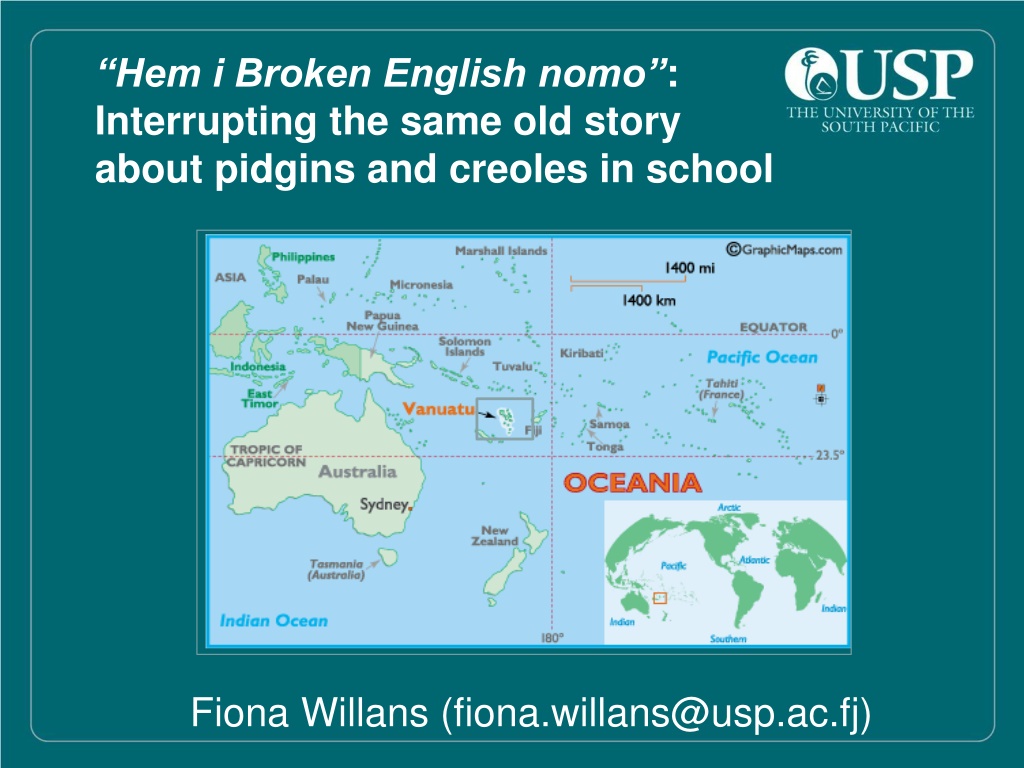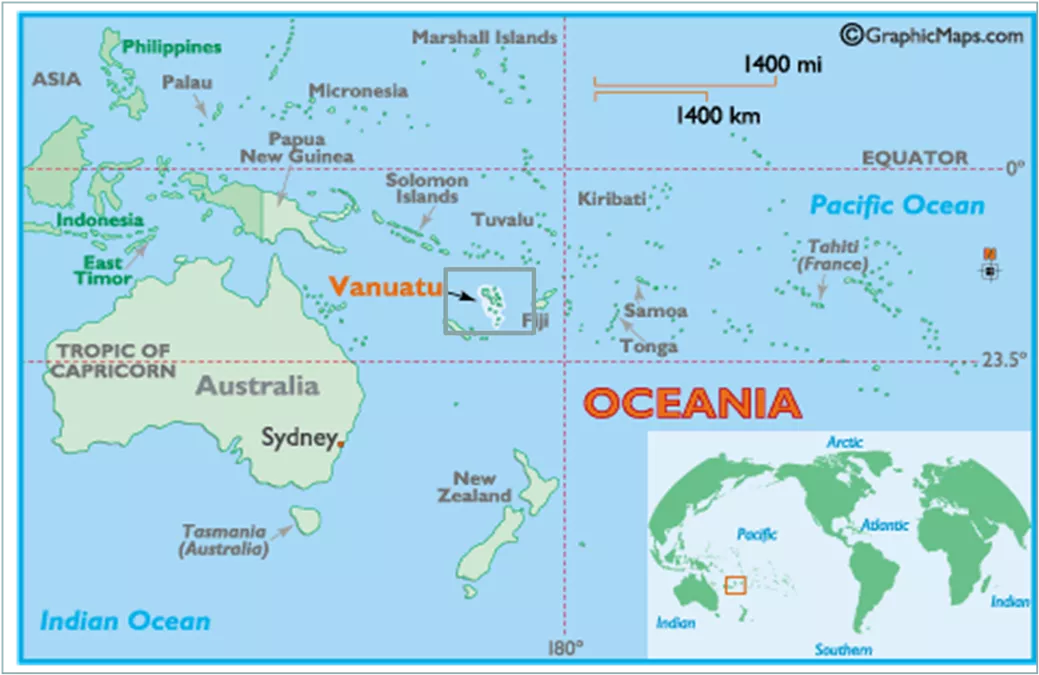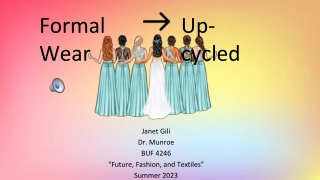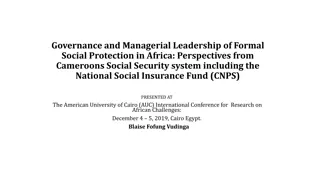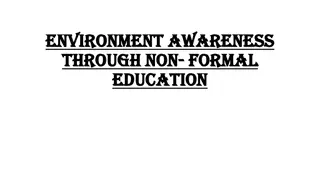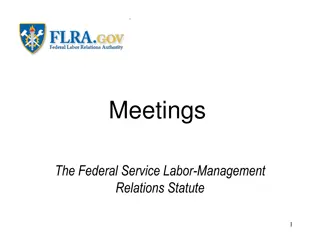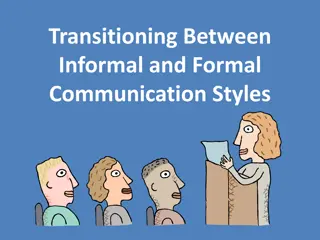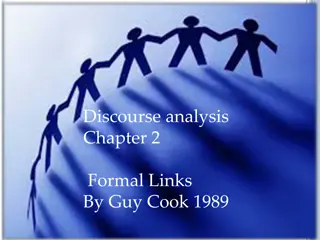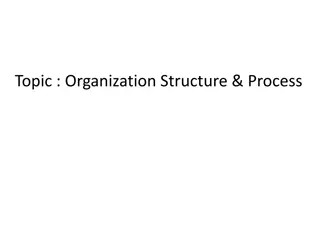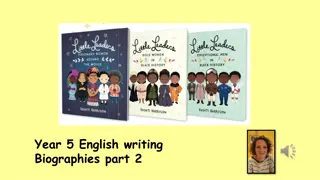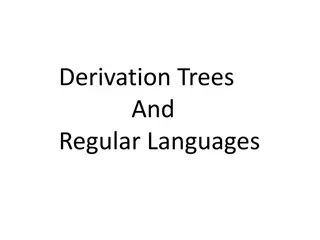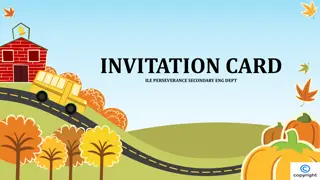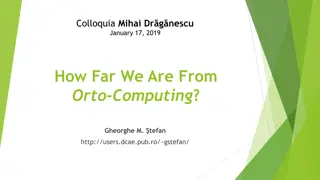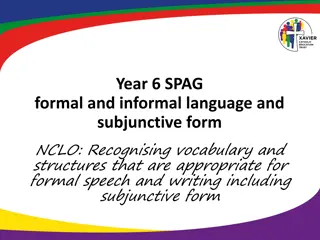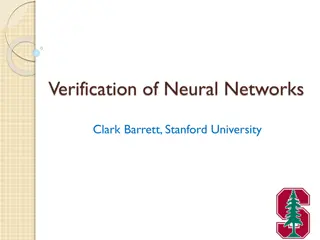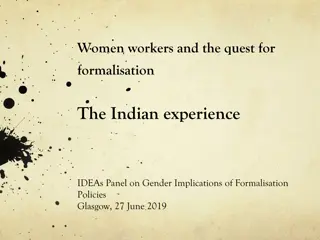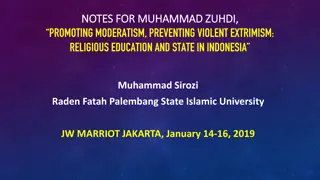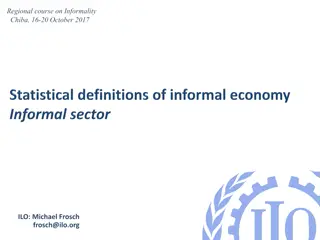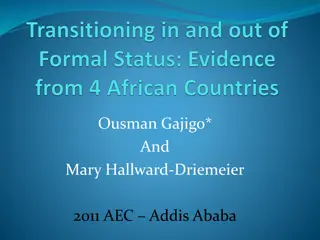Challenges in Promoting Bislama in Formal Education
Bislama, a pidgin language in Vanuatu, faces stigma in formal education despite its significance in national identity. Arguments against its use cite similarities to broken English, vocabulary limitations, and disruptions to English fluency. Efforts to shift from deficit to difference approaches in language education raise questions about embracing multilingual repertoires. The struggle to integrate Bislama highlights complex attitudes toward indigenous languages in educational contexts.
Uploaded on Sep 20, 2024 | 0 Views
Download Presentation

Please find below an Image/Link to download the presentation.
The content on the website is provided AS IS for your information and personal use only. It may not be sold, licensed, or shared on other websites without obtaining consent from the author.If you encounter any issues during the download, it is possible that the publisher has removed the file from their server.
You are allowed to download the files provided on this website for personal or commercial use, subject to the condition that they are used lawfully. All files are the property of their respective owners.
The content on the website is provided AS IS for your information and personal use only. It may not be sold, licensed, or shared on other websites without obtaining consent from the author.
E N D
Presentation Transcript
Hem i Broken English nomo: Interrupting the same old story about pidgins and creoles in school Fiona Willans (fiona.willans@usp.ac.fj)
A quick summary ... Bislama, like many pidgins and creoles, is stigmatised in formal education (See Siegel 1999, 2007). (Most of) the arguments made against its use in schools can be dismissed relatively easily, And yet the negative attitudes persist. Therefore ... arguing that Bislama is different but equal to English (and French) doesn t seem to help. We have tried to move from deficit to difference , but should we go beyond this to repertoire (cf. Snell, 2013)?
Background to Bislama An English-based expanded pidgin The national variety of Melanesian Pidgin spoken in Vanuatu (mutually intelligible with PNG Tok Pisin and Solomon Pijin) High status: Co-official language with English & French, and sole national language; language of national symbols/anthems Widely used outside school in numerous domains (as L2 for majority of the population, with approx. 106 other languages spoken) Unwelcome in schools ...
18th June 2004 Re: College Language Policy This notice serves to remind the community that the use of Bislama is banned from the whole campus. Anyone caught speaking Bislama in any area will be savagely punished. This is essential because Bislama: 1.has minimal vocabulary 2.influences spoken and written English 3.confuses the structure and word order of English 4.disturbs the fluency of English in the college Thank you for your attention College Administration
Typical arguments made against the use of pidgins and creoles in education (1) Bislama is just broken English Bislama hem i wan (.) wan lanwis blong communication nomo. Hem ino gat wan samting blong writing. Olsem yumi raetem yumi raetem long own tingting blong grammaire blong yumi. Vocabulary blong yumi nomo yumi raetem. Se yu wanem. Yu wantem save wanem nao yu raetem. Be i no gat wan proper vocabulary blong bambae yumi tokbaot o yumi lukluk long hem. Se no. Wod ia yu raetem olsem wanem. EXTRACT 1 (Francophone principal)
Bislama is just Broken English? Bae mitufala i go long solwota. By-and-by me two fellows he go along saltwater.??? Mi lukum man ia we hem i wok long bank. Me look man here where him he work along bank.???
Bislama is just Broken English ^ Bae mitufala i go long solwota. FUT 1EXCL-DL PRED go PREP sea By-and-by me two fellows he go along saltwater.??? We re going to the sea. Mi lukum man ia we hem i wok long bank. 1SG see-TRANS man DEM REL 3SG PRED work PREP bank Me look man here where him he work along bank.??? I saw the man that works at the bank.
Typical arguments made against the use of pidgins and creoles in education (2) Bislama is unstable Naoia yumi stap speak/im uh Bislama? Naoia ol brokenwannomo. I no wan gudwan nating? Yestedei i gat wan expression blong one particular thing tudei bae hem i defren. Tumora yumi tok defren lanwis nao. (Francophone-educated Anglophone teacher) EXTRACT 2
But the same seems true of other languages Mi save talem se mi save French from mi stap long environment blong yumi hemia. But (.) mi gat kwestin. Mi gat kwestin sapos we mi go long wan environment we oli toktok French naoia? Se bae mi catch up wetem olgeta? From actually French hem i wan kaen lanwis we olsem hem i laef. Oli jenisim ol long ol expression olsem we yumi talem Bislama tudei. (The same Anglophone teacher) EXTRACT 3
Typical arguments made against the use of pidgins and creoles in education (3) Time-on-task Sapos yumi tij long Franis? Then yumi mas traem blong emphasise se (1) yumi toktok er Franis nomo blong helpem pikinini blong hem i improve/m (.) Franis blong hem. EXTRACT 4 (Francophone teacher)
But how much language is actually being used by the students? Angolovo College Year 10 classroom Coll ge de Faranako Year 10 classroom Pour calculer la croissance de la population ... What is rumination?
Typical arguments made against the use of pidgins and creoles in education (4) Interference From wanem ol French oli lanem (.) oli speak gud Inglis mo bitim yumi? From oli lanem long ej we olsem oli mature. Oli lanem Inglis. Then oli lanem wan gud Inglis oli speak wan gud Inglis. Yumi from yumi statem long kindy i kam antap ia? Olsem yumi miksim Bislama wetem Inglis (.) yumi miksim gogo taem yumi kam antap ia? EXTRACT 5 (Anglophone teacher)
But, for Francophones, Bislama is an advantage Long saed blong mifala olFrancophone? Hemia blong lanem (.) Inglis? Hemia hem i isi nomo. That s why pikinini hem i? Yu toktok Inglis insaed long klas? I ansarem yu long Inglis. Hem i save ansarem yu long Inglis. Be hemia long saed blong ol (.) Anglophone? Blong yu givim French long hem? Sore tumas <others laugh>. I had we i had we i had. (Francophone teacher) EXTRACT 6
The jury is still out on this one ... There is likely to be some kind of influence on the use of English BUT pretending that Bislama doesn t exist will not make it go away (cf. Malaria eradication campaign) And why is there no interrogation of the use of French as a medium of instruction if it s so hard? Negative implications for EFL teaching if it s considered possible to simply pick it up
Typical arguments made against the use of pidgins and creoles in education (5) No resources exist Tudei ol sabjek blong yumi we yumi stap yusum long skul? Tugeta oli yusum Inglis wetem French. Yumi stap lanem blong yumi save andastanem ol wod/s we olsem oli hadinsaed long ol buk. From sapos yumi lanem ol narafala lanwis? Naoia bae i mekem i difficult blong yumi nao. Blong yumi andastanem ol wod/s insaed long buk. EXTRACT 7 (Anglophone student)
But there are very few books in any language Most teaching is done using blackboard and chalk There are very few copies of textbooks Expensive resources would undoubtedly be useful, but the lack of multilingual resources cannot be used to justify continuing with poorly-resourced English-only or French-only education
To sum up the anti-Bislama arguments Bislama is thought to be a form of Broken English, with unstable vocabulary, that prevents fluency in the school language, and interferes with the learning of English. Since there are limited Bislama materials, it is considered impossible to use it in education BUT linguists consider it to be a systematic language, subject to development like all others. They argue that banning Bislama leads neither to greater use of English/French, nor to greater learning of English. With so few resources in any language, the final argument is rather irrelevant.
From deficit to difference ... (now 50 years) Over the past 35 years, linguists have shown that these varieties are legitimate, rule-governed forms of language and in no way intrinsically inferior to the standard (e.g., Labov, 1969). But as Mackey (1978) has noted, Only before God and linguists are all languages equal (p.7) (Siegel, 1999, p.702) ... makes little difference
Snell (2013) moves beyond difference ... Sociolinguists have been fighting dialect prejudice since the 1960s, but deficit views of non-standard English are regaining currency in educational discourse. ... I argue that the traditional sociolinguistic response stressing dialect systematicity and tolerance of difference may no longer be effective by questioning a key assumption that both deficit and difference approaches share, namely that there exist discrete varieties of English. (Snell, 2013, p.110)
e.g. Standard English vs. Tyneside English: Two discrete grammatical systems? STANDARD TYNESIDE Extract from a typical pronoun paradigm Subject Object Subject Object 1SG I Me I Us 1PL We Us Us We (based on Snell, 2013, p.114, orig. from Beal, 1993) 2SG You You Ye You 2PL You You Yous Yous/Yees 1SG Obj Ironside School Murrayfield School Distribution of Standard and Teesside/Tyneside variants of 1SG Obj pronoun at two schools N % N % Me 285 83.1 300 96.2 Us 58 16.9 12 3.8 343 312 (Snell, 2013, p.114)
Snells argument with regard to the speech of working class children in Teesside Children have access to both Standard and dialect variants e.g. Singular us ( Give us my shoe back ) is not simply the dialect equivalent of Standard me , as is suggested by dialect pronoun paradigms Children employ us and me in different ways, indexing solidarity/distance etc., and demonstrating communicative competence The Standard and dialect features interact within complex repertoires, rather than in a binary between two discrete varieties It is the educational response to dialect features that is problematic, rather than pupils lack of access to the Standard features
Recent sociolinguistic challenges to the boundaries around separate languages Distinct, named, bounded languages are considered to be ideological constructions based on sociocultural/ politico- historical, rather than linguistic, criteria (Makoni & Pennycook, 2007; Blackledge & Creese, 2010; Blommaert & Rampton, 2011; J rgensen et al, 2011) A shift towards thinking in terms of linguistic repertoires: the composite of resources that a speaker actually uses, and knows how to use appropriately (cf. abstract linguistic models) (Hymes, 1996) Snell (2013) applies this argument to the study of dialects of English How do English-based pidgins and creoles fit in?
Linguistic distance? Bislama is lexically very close to English, but morpho-syntactically distant (easier to argue for a distinct grammatical paradigm) Some indication of a continuum between acrolectal and basilectal forms (but not to the extent seen in contexts where English is more widely spoken) Acrolectal forms might include English plural marking on the noun, in addition to the prenominal plural marker ol (e.g. ol buk ol buks) But also Bislama transitive marking on a verb not typically used in Bislama (e.g. implement-em)
Linguistic usage yes long wan uh lanwis polisi summit we i bin take place long Saratamata? olsem (.) gavman hem i reorganise/em lanwis/es blong yumi tijim long ol skul/s nao. wan nao hem i (.) wanem ia vernacular o wanem ia? ol lokol lanwis/es ia? then Inglis mo French. be (.) Bislama oli discourage/im. so hemia nao wan long olgeta samting (.) from why? olsem we mi bin talem finis. i no gat vocabulary blong hem (.) hem i (.) hem i no gat vocabulary. hem i too difficult.
Educational responses If Bislama is a separate language from English: English (or French) is the expected language of schooling and assessment, so all other languages are marginalised (by being OTHER languages) Lack of competence in the right language shuts down classroom talk and participation (and thus potentially academic achievement)
If Bislama is a separate language from English: Both languages are validated as systems in their own right Codification Policies can make space for bilingual education M T W T F Bis Bis Bis Bis Bis Bis Bis Bis Bis Bis Resources can be created Eng Eng Eng Eng Eng Eng Eng Eng Eng Eng But there will always be more resources already available in languages with more established traditions in education, and these languages will remain in competition with each other.
If Bislama, English, French, etc. are separate languages Hours per week on the timetable (in a recent proposal) K Vernacular Bislama French English 1 2 3 Grades Kindergarten to 13 4 5 6 7 8 9 10 Multiple monolingualisms (Banda 2009; Heugh 2003; Makoni & Pennycook 2007) 11 Sciences / Arts 12 Arts / Sciences 13 they are not all given equal space
An alternative? Will it work to stop thinking about languages of instruction, and think instead of repertoires of instruction? Can we focus on learning/communication, rather than on language, allowing teachers and students to draw flexibly on whatever linguistic resources they have access to? Can we therefore work towards a learning-oriented form of language policy, rather than a language- oriented education policy?
only only only only (Other languages banned) (Other languages banned) (No time for others) (No time for others)
only only only only (Other languages banned) (Other languages banned) (No time for others) (No time for others)
Tangkiu tumas Thoughts or comments? fiona.willans@usp.ac.fj
References Banda, F. (2009). Critical perspectives on language planning and policy in Africa: Accounting for the notion of multilingualism. Stellenbosch Papers in Linguistics PLUS, 38, 1-11. Blackledge, A., & Creese, A. (2010). Multilingualism: A critical perspective. London: Continuum. Blommaert, J., & Rampton, B. (2011). Language and superdiversity: A position paper. Working Papers in Urban Language & Literacies, 70. Heugh, K. (2003). Language policy and democracy in South Africa: The prospects of equality within rights-based policy and planning. (PhD), Stockholm University. Hymes, D. (1996). Ethnography, linguistics, narrative inequality: Toward an understanding of voice. London: Taylor & Francis. J rgensen, N., Karreb k, M., Madsen, L., & M ller, J. (2011). Polylanguaging in superdiversity. Diversities, 13(2). Makoni, S., & Pennycook, A. (2007). Disinventing and Reconstituting Languages. Clevedon: Multilingual Matters. Siegel, J. (1999). Stigmatized and standardized varieties in the classroom: Interference or separation? TESOL Quarterly, 33(4), 701-728. Siegel, J. (2007). "Creoles and minority dialects in education: An update." Language and Education 21(1): 66-86. Snell, J. (2013). Dialect, interaction and class positioning at school: From deficit to difference to repertoire. Language and Education, 27(2), 110-128.
